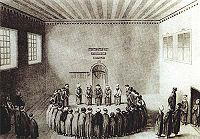
Photo from wikipedia
OBJECTIVES The purpose of the study is to examine the characteristics of various types of meditation use (i.e., mantra, mindful, and spiritual meditation) among U.S. children. METHODS Using 2017 National… Click to show full abstract
OBJECTIVES The purpose of the study is to examine the characteristics of various types of meditation use (i.e., mantra, mindful, and spiritual meditation) among U.S. children. METHODS Using 2017 National Health Interview Survey, we examined the prevalence, patterns, and potential predictors of meditation use among U.S. children aged 4 to 17 years. Descriptive statistics, Wald F chi-square test, and multivariable logistic regression were used for data analysis (n = 6925). RESULTS Overall meditation use has increased substantially from 1.6% in 2012 to 7.4% in 2017 among children in the US. Children with chronic medical conditions were more likely to use mindful meditation (Adjusted Odds Ratio (AOR) = 1.9-3.6, 95% CI [1.0-7.4]). Regularly taking prescription medication had an inverse relation with mantra meditation use (AOR = 0.4, 95% CI [0.2-0.9]). Children with delayed medical care due to access difficulties were more likely to use spiritual meditation, compared to those who did not (AOR = 1.7, 95% CI [1.1-2.6]). CONCLUSIONS Meditation use has rapidly increased among U.S. children within the past few years. Future studies should explore the underlying reasons for this increase and its potential benefits for pediatric meditators.
Journal Title: Complementary therapies in medicine
Year Published: 2019
Link to full text (if available)
Share on Social Media: Sign Up to like & get
recommendations!